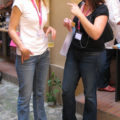a follow-up to How TV Could Make Money Distributing Shows Online
Joss Whedon, the creator of Buffy the Vampire Slayer, has one last refuge on television this year: “Angel,” the Buffy spinoff, eagerly followed by fans of the “Buffyverse.” But not for long. The show has been cancelled by its broadcaster, the WB, as of the end of this season, its fifth.
Apparently this has to do with the economics of television. After a show has run five years, costs such as actor salaries go up, I guess by some automatic TV industry mechanism, causing the overall price of a show to rise, just about the time that its creative energy is often waning, running the risk of a more-expensive show attracting fewer viewers. This problem arose with “Buffy” three years ago. Reports are that, during contract negotiations about what would happen after the show’s fifth year, the WB refused to pay more than $1.8 million per episode, which wasn’t enough for Fox, the show’s producer. Rival broadcaster UPN offered $2.3 million per episode, for two years, and that was how Buffy ran to seven seasons.
The cancellation of “Angel” was announced a few weeks ago, to furious reaction from fans and media commentators. Thousands of fans worldwide are supporting “save the show” efforts, sending postcards and even raising money to run ads in industry papers such as Variety. All for naught, apparently. The most likely candidate to pick up the show would have been, again, UPN, but they have now officially declined, saying that they made a mistake to pick up “Buffy” so late in its life – they lost money on it.
I’m disappointed that “Angel” will end, but am mulling over how a change in television distribution, such as the one I fantasized about earlier, might save shows like this, whose millions of viewers are still not quite enough for a show to survive the economics of traditional broadcast television.
Some facts supporting my idea:
- Many “Angel” fans worldwide already go to some trouble to download the show (illegally), because it is not shown where they live until months after its US airdate – or not at all.
- Many (most?) of these fans then go on to buy the show on DVD as soon as available. The production companies don’t release sales figures for DVDs, but Angel Season 4 was released in the UK on Monday, and today it’s ranked among the ten top sellers on Amazon.co.uk (consider that most of us rabid fans pre-ordered it weeks or months ago, so are not counted in today’s sales figures).
- Fox Filmed Entertainment, producers of Buffy, made $250 million selling DVDs of television shows in 2003, its top three sellers being “24? (season 1), “The Simpsons” (seasons 1 and 2) and “Buffy” (season 3). It’s been widely reported lately that sales of such TV DVDs are booming, so we can probably expect Fox’s earnings on Angel and Buffy to grow this year.
- Although Whedon’s Firefly series died on television over a year ago (ratings – only four million viewers or so), its release on DVD has been a huge success. Again, no hard numbers are available, but it has been a top seller on Amazon since it was announced last July – and it didn’t actually ship until December. Sales have been good enough that Universal Pictures has now given the go-ahead for a film version. (Yay!)
There are similar examples from other shows, but I won’t bore you with the details. My point is: broadcast television is not a viable medium for some niche TV shows, but the audiences for those shows might be large enough to support them via some other distribution method. If every one of Angel’s 4 million weekly viewers was willing to pay $1 per episode, that should be plenty to cover both production and distribution costs, including generous cuts for the middlemen.
So what are the production companies waiting for?
Mar 28, 2004
I have now found the hard numbers:
The “Firefly” DVD has sold a surprising 200,000 copies since it was released last December. (The release fortuitously came out while U execs were debating greenlighting the pic.) – Variety









